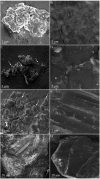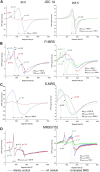Exploring Fingerprints of the Extreme Thermoacidophile Metallosphaera sedula Grown on Synthetic Martian Regolith Materials as the Sole Energy Sources
- PMID: 29062303
- PMCID: PMC5640722
- DOI: 10.3389/fmicb.2017.01918
Exploring Fingerprints of the Extreme Thermoacidophile Metallosphaera sedula Grown on Synthetic Martian Regolith Materials as the Sole Energy Sources
Abstract
The biology of metal transforming microorganisms is of a fundamental and applied importance for our understanding of past and present biogeochemical processes on Earth and in the Universe. The extreme thermoacidophile Metallosphaera sedula is a metal mobilizing archaeon, which thrives in hot acid environments (optimal growth at 74°C and pH 2.0) and utilizes energy from the oxidation of reduced metal inorganic sources. These characteristics of M. sedula make it an ideal organism to further our knowledge of the biogeochemical processes of possible life on extraterrestrial planetary bodies. Exploring the viability and metal extraction capacity of M. sedula living on and interacting with synthetic extraterrestrial minerals, we show that M. sedula utilizes metals trapped in the Martian regolith simulants (JSC Mars 1A; P-MRS; S-MRS; MRS07/52) as the sole energy sources. The obtained set of microbiological and mineralogical data suggests that M. sedula actively colonizes synthetic Martian regolith materials and releases free soluble metals. The surface of bioprocessed Martian regolith simulants is analyzed for specific mineralogical fingerprints left upon M. sedula growth. The obtained results provide insights of biomining of extraterrestrial material as well as of the detection of biosignatures implementing in life search missions.
Keywords: EPR spectroscopy; Martian regolith simulants; Metallosphaera sedula; biosignatures; microbe–mineral interactions.
Figures




Similar articles
-
Biotransformation of Scheelite CaWO4 by the Extreme Thermoacidophile Metallosphaera sedula: Tungsten-Microbial Interface.Front Microbiol. 2019 Jul 2;10:1492. doi: 10.3389/fmicb.2019.01492. eCollection 2019. Front Microbiol. 2019. PMID: 31312192 Free PMC article.
-
Exploring the microbial biotransformation of extraterrestrial material on nanometer scale.Sci Rep. 2019 Dec 2;9(1):18028. doi: 10.1038/s41598-019-54482-7. Sci Rep. 2019. PMID: 31792265 Free PMC article.
-
Nanoscale Tungsten-Microbial Interface of the Metal Immobilizing Thermoacidophilic Archaeon Metallosphaera sedula Cultivated With Tungsten Polyoxometalate.Front Microbiol. 2019 Jun 7;10:1267. doi: 10.3389/fmicb.2019.01267. eCollection 2019. Front Microbiol. 2019. PMID: 31275255 Free PMC article.
-
Paleo-Rock-Hosted Life on Earth and the Search on Mars: A Review and Strategy for Exploration.Astrobiology. 2019 Oct;19(10):1230-1262. doi: 10.1089/ast.2018.1960. Epub 2019 Jun 25. Astrobiology. 2019. PMID: 31237436 Free PMC article. Review.
-
Life on Mars: chemical arguments and clues from Martian meteorites.Extremophiles. 1998 Aug;2(3):313-9. doi: 10.1007/s007920050074. Extremophiles. 1998. PMID: 9783179 Review.
Cited by
-
Biotransformation of Scheelite CaWO4 by the Extreme Thermoacidophile Metallosphaera sedula: Tungsten-Microbial Interface.Front Microbiol. 2019 Jul 2;10:1492. doi: 10.3389/fmicb.2019.01492. eCollection 2019. Front Microbiol. 2019. PMID: 31312192 Free PMC article.
-
Exploring the microbial biotransformation of extraterrestrial material on nanometer scale.Sci Rep. 2019 Dec 2;9(1):18028. doi: 10.1038/s41598-019-54482-7. Sci Rep. 2019. PMID: 31792265 Free PMC article.
-
Phosphorus-solubilizing bacteria improve the growth of Nicotiana benthamiana on lunar regolith simulant by dissociating insoluble inorganic phosphorus.Commun Biol. 2023 Nov 9;6(1):1039. doi: 10.1038/s42003-023-05391-z. Commun Biol. 2023. PMID: 37945659 Free PMC article.
-
Improved protocol for metabolite extraction and identification of respiratory quinones in extremophilic Archaea grown on mineral materials.Front Microbiol. 2025 Jan 8;15:1473270. doi: 10.3389/fmicb.2024.1473270. eCollection 2024. Front Microbiol. 2025. PMID: 39845047 Free PMC article.
-
"Freezing" Thermophiles: From One Temperature Extreme to Another.Microorganisms. 2022 Dec 6;10(12):2417. doi: 10.3390/microorganisms10122417. Microorganisms. 2022. PMID: 36557670 Free PMC article. Review.
References
-
- Amils R., González-Toril E., Fernández-Remolar D., Gómez-Gómez F., Aguilera Á, Rodríguez N., et al. (2007). Extreme environments as Mars terrestrial analogs: the rio tinto case. Planet. Space Sci. 55 370–381. 10.1016/j.pss.2006.02.006 - DOI
-
- Auernik K. S., Kelly R. M. (2008). Identification of components of electron transport chains in the extremely thermoacidophilic crenarchaeon Metallosphaera sedula through iron and sulfur compound oxidation transcriptomes. Appl. Environ. Microbiol. 74 7723–7732. 10.1128/AEM.01545-08 - DOI - PMC - PubMed
-
- Auernik K. S., Maezato Y., Blum P. H., Kelly R. M. (2008). The genome sequence of the metal- mobilizing, extremely thermoacidophilic archaeon Metallosphaera sedula provides insights into bioleaching-associated metabolism. Appl. Environ. Microbiol. 74 682–692. 10.1128/AEM.02019-07 - DOI - PMC - PubMed
LinkOut - more resources
Full Text Sources
Other Literature Sources
Miscellaneous

